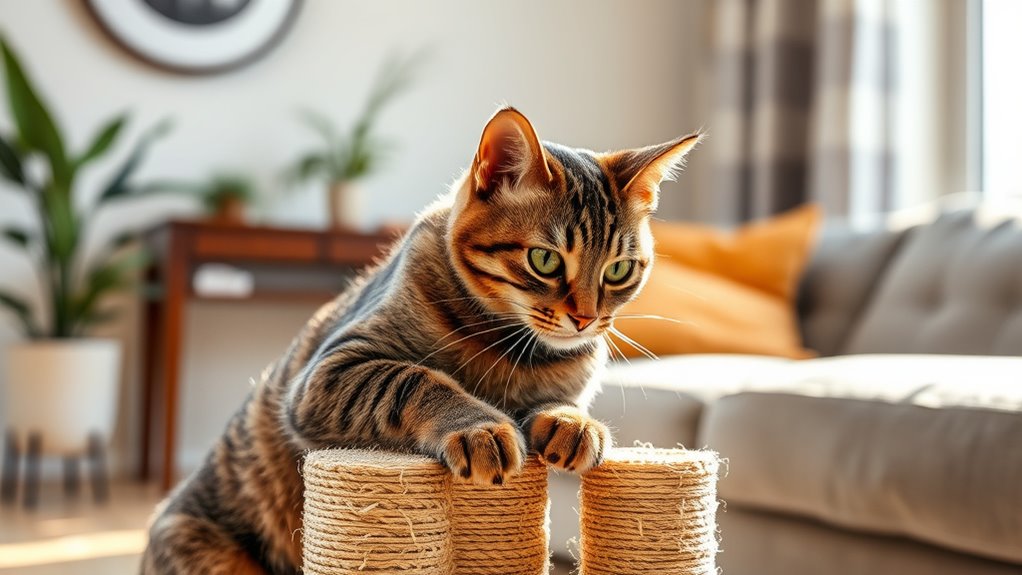Cat scratching behavior serves vital purposes. It maintains their claws and expresses natural instincts. Scratching helps mark territory with scent and visual cues, giving your cat a sense of security. To prevent furniture damage, provide scratching posts or pads made of varied textures. Place these in spots your cat frequently scratches and encourage them with treats or catnip. This satisfies their needs while keeping your home intact. Discover more ways to enhance your cat’s environment!
Key Takeaways
- Scratching is essential for a cat’s claw maintenance, helping to keep claws sharp and healthy.
- Cats scratch to mark their territory with both visual and scent markers, reinforcing their sense of security.
- Recognizing scratching behavior helps owners understand their cat’s natural instincts and environmental needs.
- Providing scratching posts or pads can redirect scratching away from furniture and reduce damage.
- Enhancing the environment with various scratching surfaces promotes mental stimulation and supports overall well-being.

When you bring a cat into your home, you might quickly notice their instinct to scratch. This behavior isn’t just a simple quirk; it serves multiple purposes that are essential to your cat’s well-being. First and foremost, scratching plays a vital role in claw maintenance. Cats have retractable claws, and scratching helps them shed the outer layers, keeping their claws healthy and sharp. When you see your cat scratching, they’re not only keeping those claws in check but also ensuring they can climb, hunt, and defend themselves if needed.
Moreover, scratching is a natural way for cats to express their territory. They have scent glands in their paws, and when they scratch, they leave behind both visual and olfactory markers that signal their presence to other animals. This territorial marking is instinctual and can help your cat feel secure in their environment. If you’ve ever seen your cat scratching the corner of a sofa or a favorite chair, they’re likely claiming that space as their own. Understanding this behavior can help you appreciate why your cat does what they do, even if it’s sometimes frustrating for you. Additionally, providing your cat with self-watering plant pots can ensure they have a stable environment that contributes to their overall sense of security.
Scratching allows cats to mark their territory, helping them feel secure while expressing their natural instincts.
To prevent damage to your furniture while still respecting your cat’s natural instincts, you can take a few proactive steps. Providing scratching posts or pads can redirect their need to scratch away from your beloved couch. Look for options with different textures and materials, as cats often have preferences. Placing these scratching surfaces in areas where your cat likes to scratch can also encourage them to use them instead.
You might also consider using catnip to attract your cat to the scratching post. Many cats love the smell of catnip, which can make those posts much more appealing than your furniture. Positive reinforcement is key, too; when you catch your cat using their scratching post, reward them with treats or affection. This way, they’ll associate the post with positive experiences, making it more likely they’ll return to it.
Frequently Asked Questions
Can Scratching Be a Sign of Stress in Cats?
Yes, scratching can definitely be a sign of stress in cats. If you notice your cat scratching more than usual, it might be a response to cat anxiety caused by environmental stressors like loud noises or changes in their surroundings. Pay attention to any triggers in their environment and consider creating a more calming space for them. Providing adequate outlets for their scratching needs can also help alleviate their stress.
How Often Should I Trim My Cat’s Claws?
Think about how often you’d want to keep your cat’s claws in check—ideally, you should trim your cat’s nails every 2-4 weeks. This keeps their claws manageable and helps reduce scratching frequency on your furniture. Regular cat nail trimming not only prevents overgrowth but also guarantees your furry friend stays comfortable. If you notice them scratching more than usual, it might be time to grab those clippers sooner!
Are Certain Cat Breeds More Prone to Scratching?
Yes, certain cat breeds do have scratching preferences and breed tendencies that can influence their behavior. For instance, breeds like the Siamese and Bengal are often more active and may scratch more frequently. However, individual personality also plays a significant role. By understanding your cat’s breed tendencies, you can create an environment that encourages appropriate scratching and satisfies their natural instincts, reducing unwanted damage to your furniture.
Can I Train My Cat to Scratch Only Specific Items?
Yes, you can train your cat to scratch only specific items! Start by using effective cat scratching techniques, like encouraging them to use a scratching post. Place the scratching post near their favorite resting spot or where they typically scratch. Reward your cat with treats or praise when they use it. Consistency’s key, so keep guiding them back to the post and gently redirecting them from unwanted surfaces. You’ll see progress over time!
What Materials Are Best for Cat Scratching Posts?
Think of a tree trunk, sturdy and inviting. For your cat, the best scratching posts are made from materials like sisal, cardboard, or untreated wood. These surfaces mimic natural textures, encouraging those satisfying cat scratch marks. Place the scratching post near their favorite lounging spots or close to where they like to scratch, ensuring it’s easily accessible. This way, your cat’s instincts are satisfied, and your furniture stays safe from those enthusiastic claws.
Conclusion
In conclusion, understanding your cat’s scratching behavior is like opening a secret door to their world. By providing appropriate scratching surfaces and engaging toys, you can redirect this natural instinct into positive outlets. Remember, patience and consistency are key to preventing unwanted scratching. With a little effort, you’ll create a harmonious environment for both you and your feline friend, ensuring they stay happy and your furniture stays safe. So, embrace their needs, and you’ll both thrive together!










